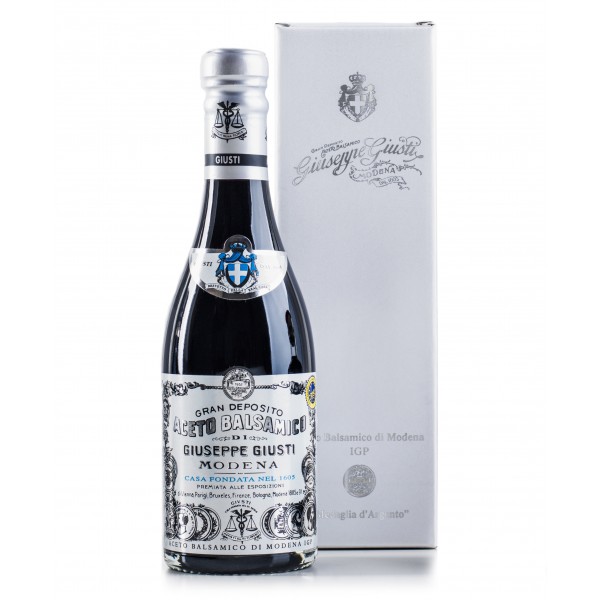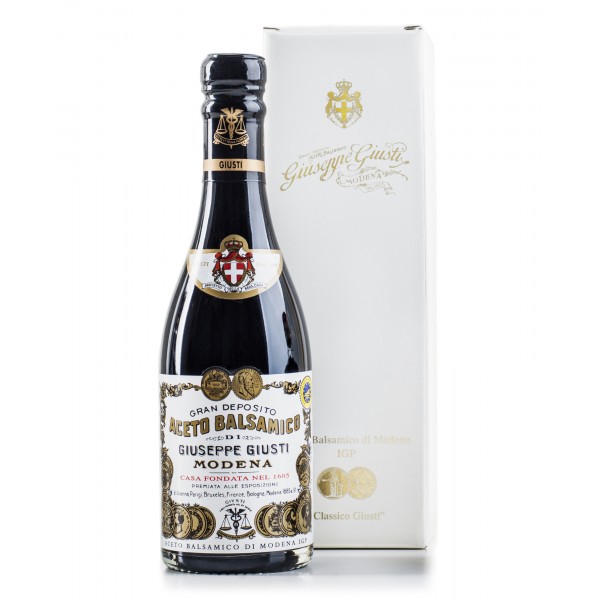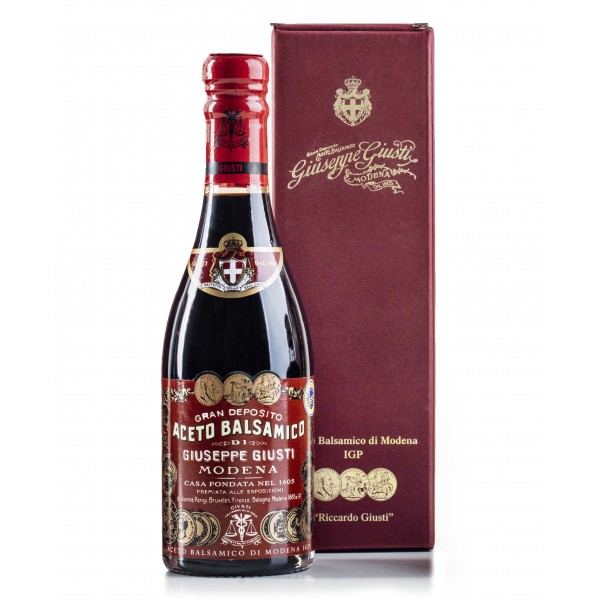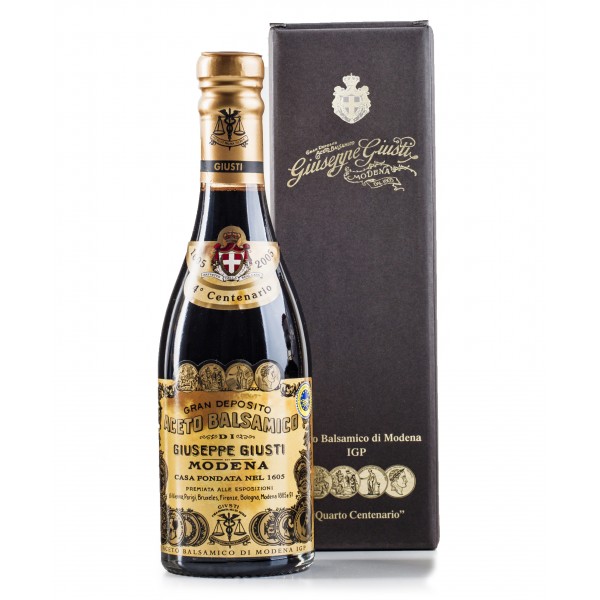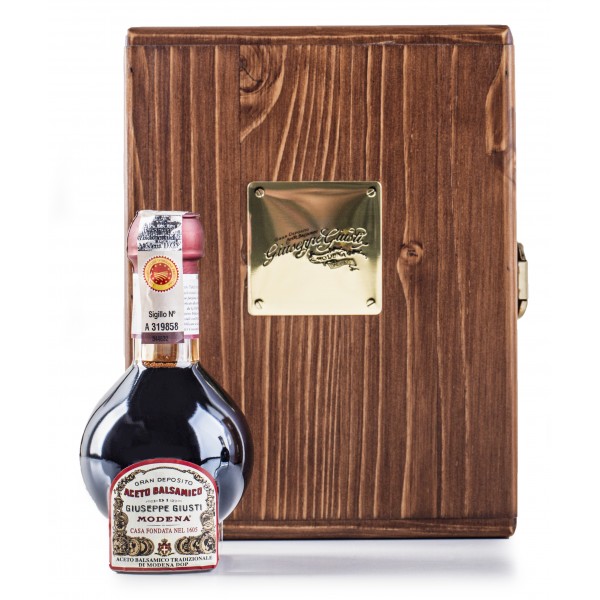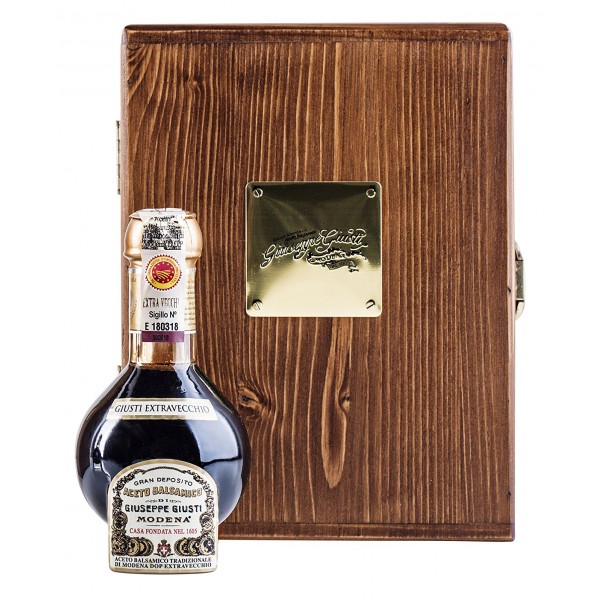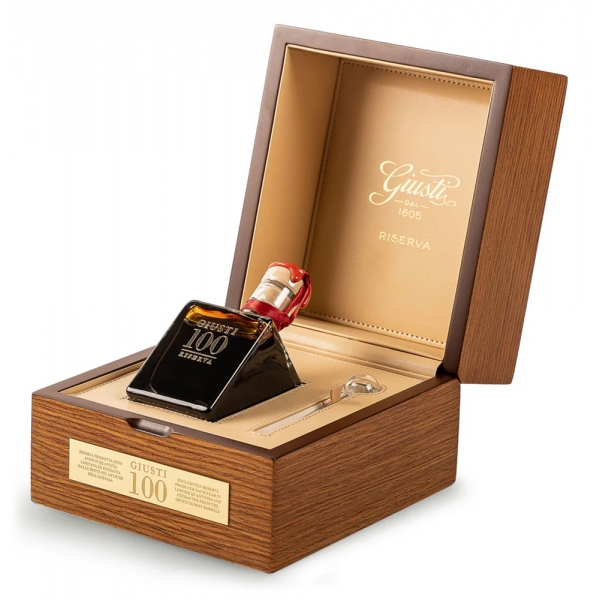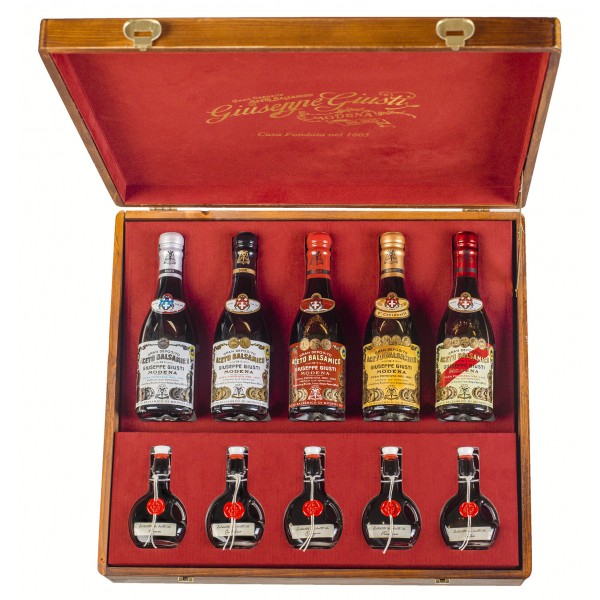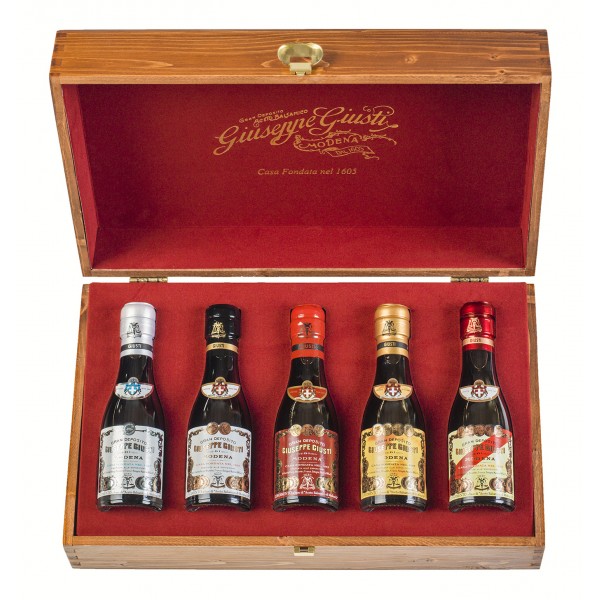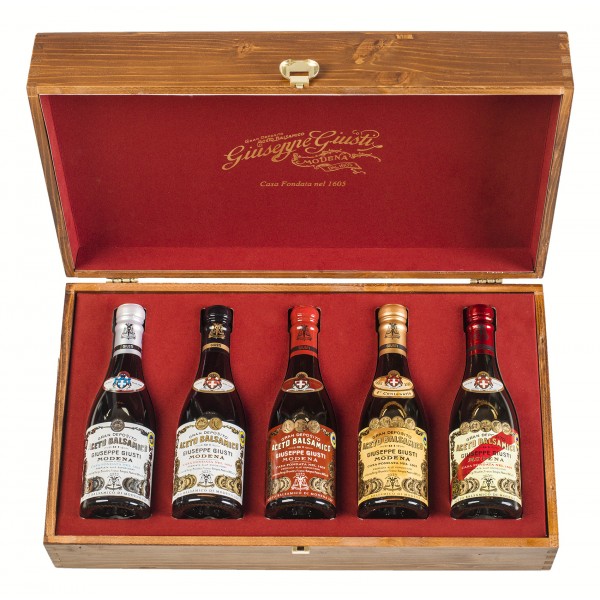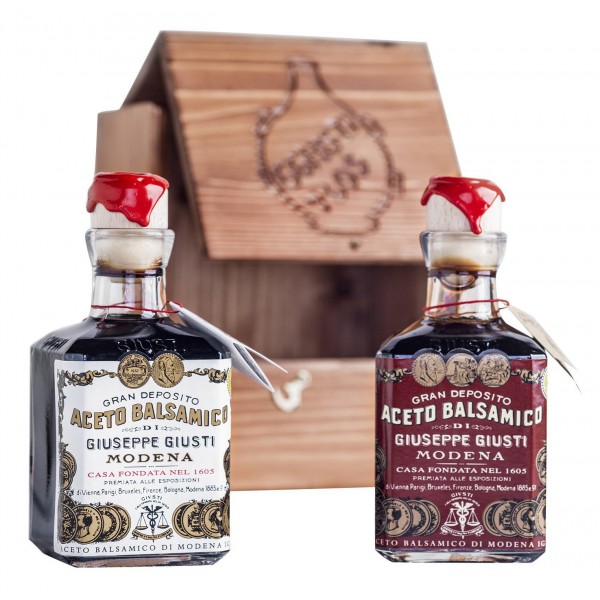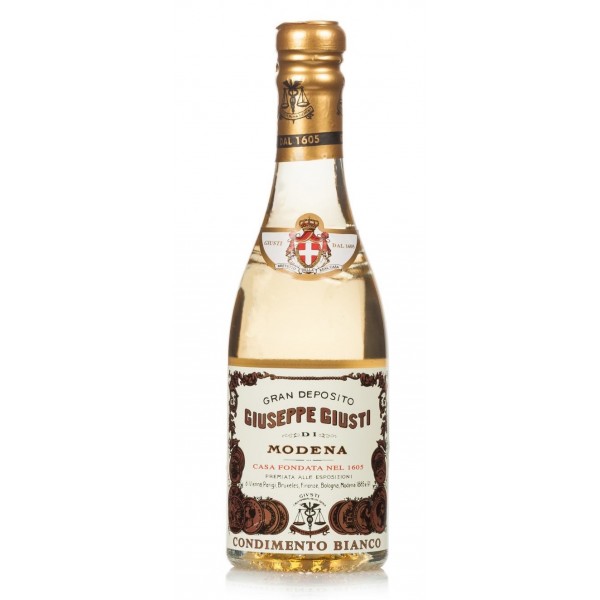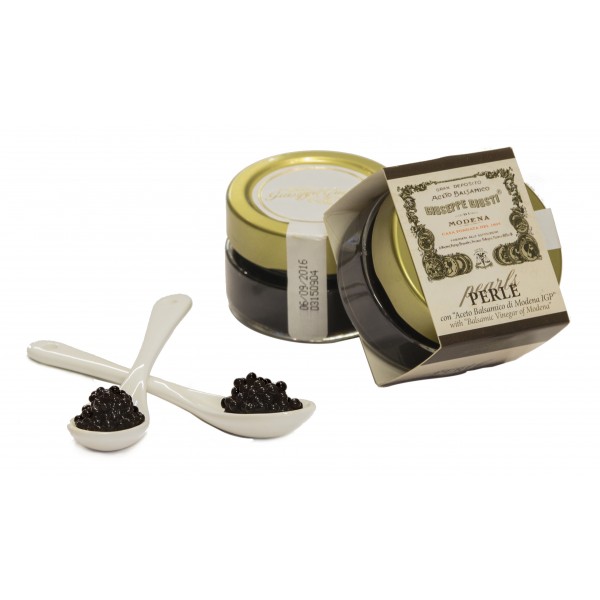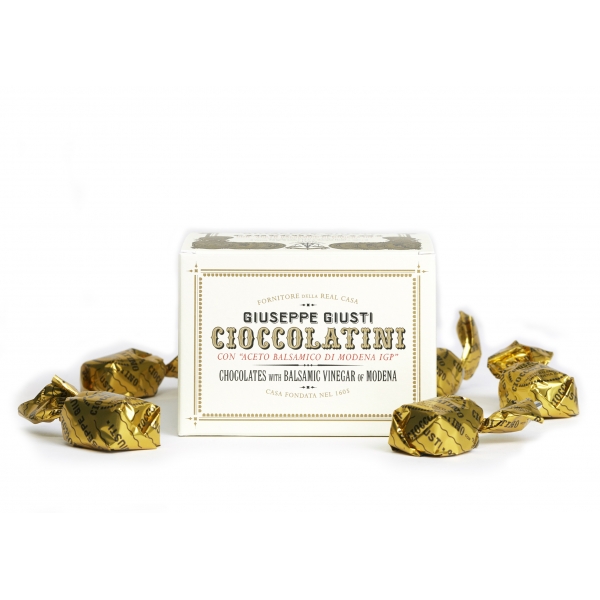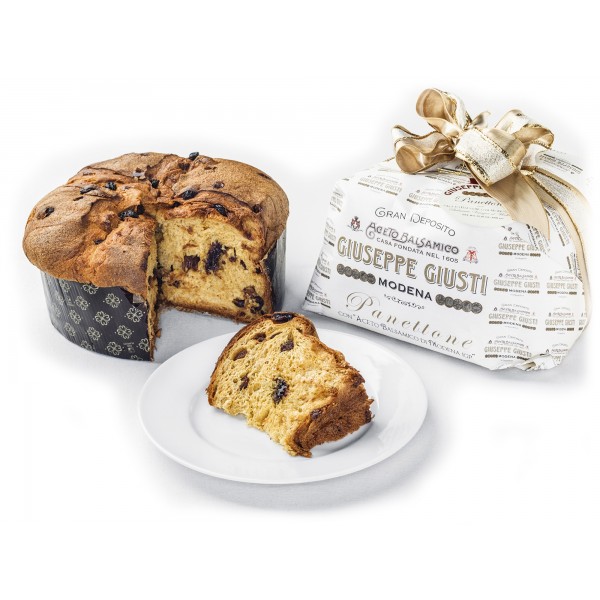No products
Categories
- Fashion Accessories
- Clothing
- Beauty & Lifestyle
-
Hi-Tech & Lifestyle
- Gaming
-
Case
- iPhone 11 Pro
- iPhone 11 Pro Max
- iPhone 11
- iPhone X / XS
- iPhone XS Max
- Samsung S10 / S10+ / S10e
- Huawei P30 / P30 Pro / P30 Lite
- Huawei P20 / P20 Pro / P20 Lite
- iPhone XR
- Samsung S9
- Samsung S9+
- iPhone 8 / 7
- iPhone 8 Plus / 7 Plus
- Samsung S8
- Samsung S8+
- Samsung S7
- Samsung S7 Edge
- iPhone 6 / 6 s
- iPhone 6 Plus / 6 s Plus
- iPhone 5 / SE
- Skin
- Audio
- Smart Home
- Drones & Hoverboard
- Photo & Video
- Desk Supplies
- Accessories
- Games
- Beverages
- Food
- Home
- Jewelry
- Luxury
- Travel
- Art
- Footwear
- Vintage Fashion
- Restaurants
- Sport
- Animals
- Gift Ideas
- Kidswear
Extra
Gran Deposito Aceto Balsamico Giuseppe Giusti
Modena since 1605 - The Oldest Vinegar Company in The World
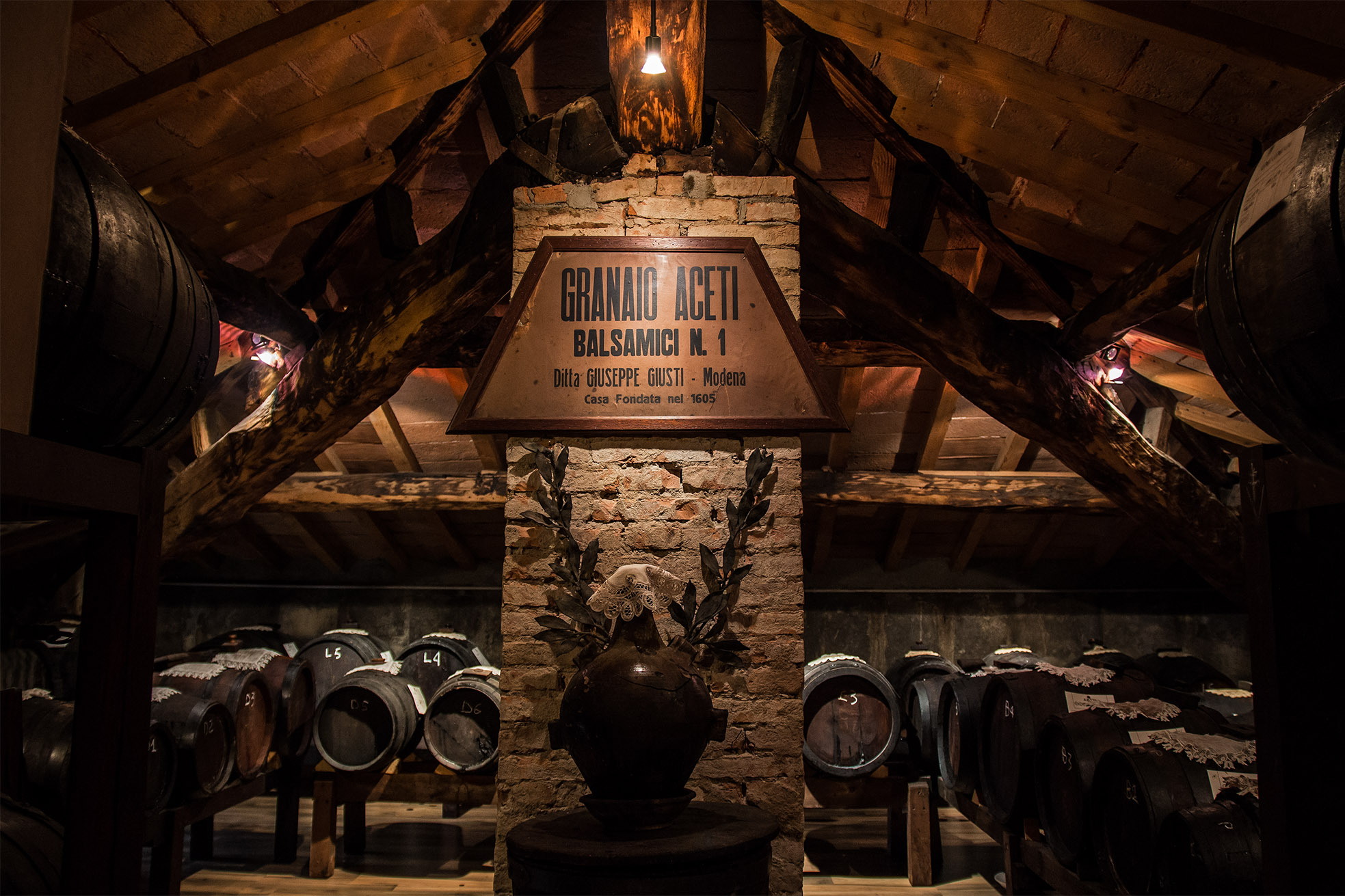
"The perfection of the Balsamic Vinegars of Modena depends solely by three conditions: choice of the grapes, quality of the recipients and Time." G. Giusti

History - Key Milestones

1605. Giuseppe and Francesco Maria Giusti are registered in the first list of commercial activities, created by Cesare d-Este, the newly crowned Duke of Modena.

1700. The Giusti production grows through the acquisition of new casks and the purchase of others already producing balsamic vinegar from families of Modena.
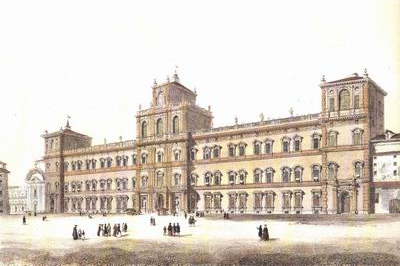
1861. Giuseppe Giusti brings the A3 barrel to the Italian National Fair in Florence, authorized by the Italian Royal family, and is awarded a gold medal for his “90 years old balsamic vinegar”.

1863. During a Fair in Modena, Giuseppe Giusti presents the first document of his “golden rules” for the “perfect balsamic vinegar”.

1880. The first “Commercial Samples” of Giusti Balsamic Vinegar are sent by post, anticipatig its future diffusion throughout Italy and Europe.

1889 - 1900. Giusti participates at International Fairs, from Paris to Antwerp, accumulating awards and medals for the outstanding quality of its balsamic vinegars.
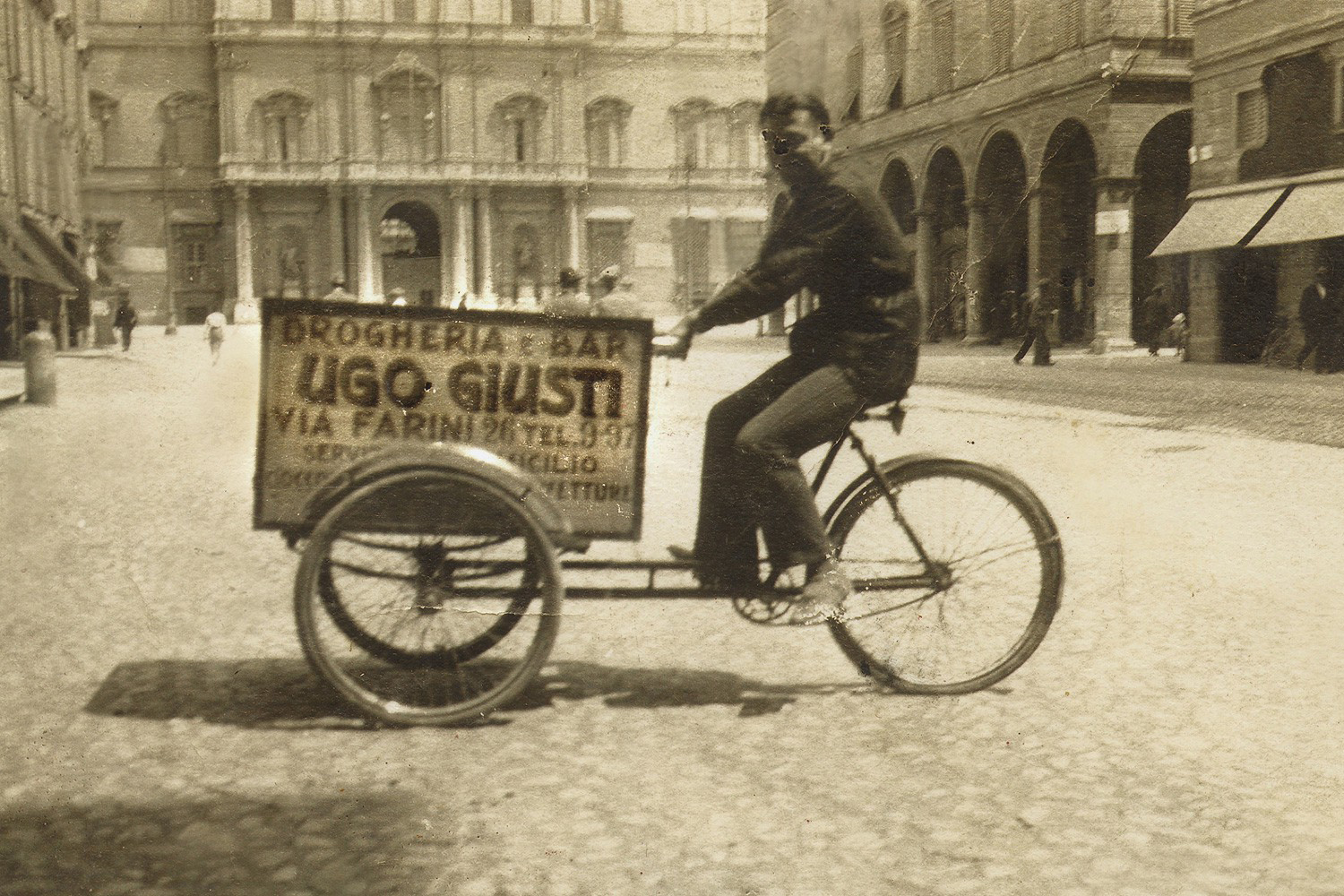
1900. The boutique, opened in the early 1600’s, becomes the “Premiata Salumeria Gisuti”, remaining throughout the centuries a point of reference for food lovers and local gourmet excellences.

1929. Giusti becomes the official supplier of the King of Italy, the Savoia family, who grants the right to add the Royal Seal of Approval to Giusti products.
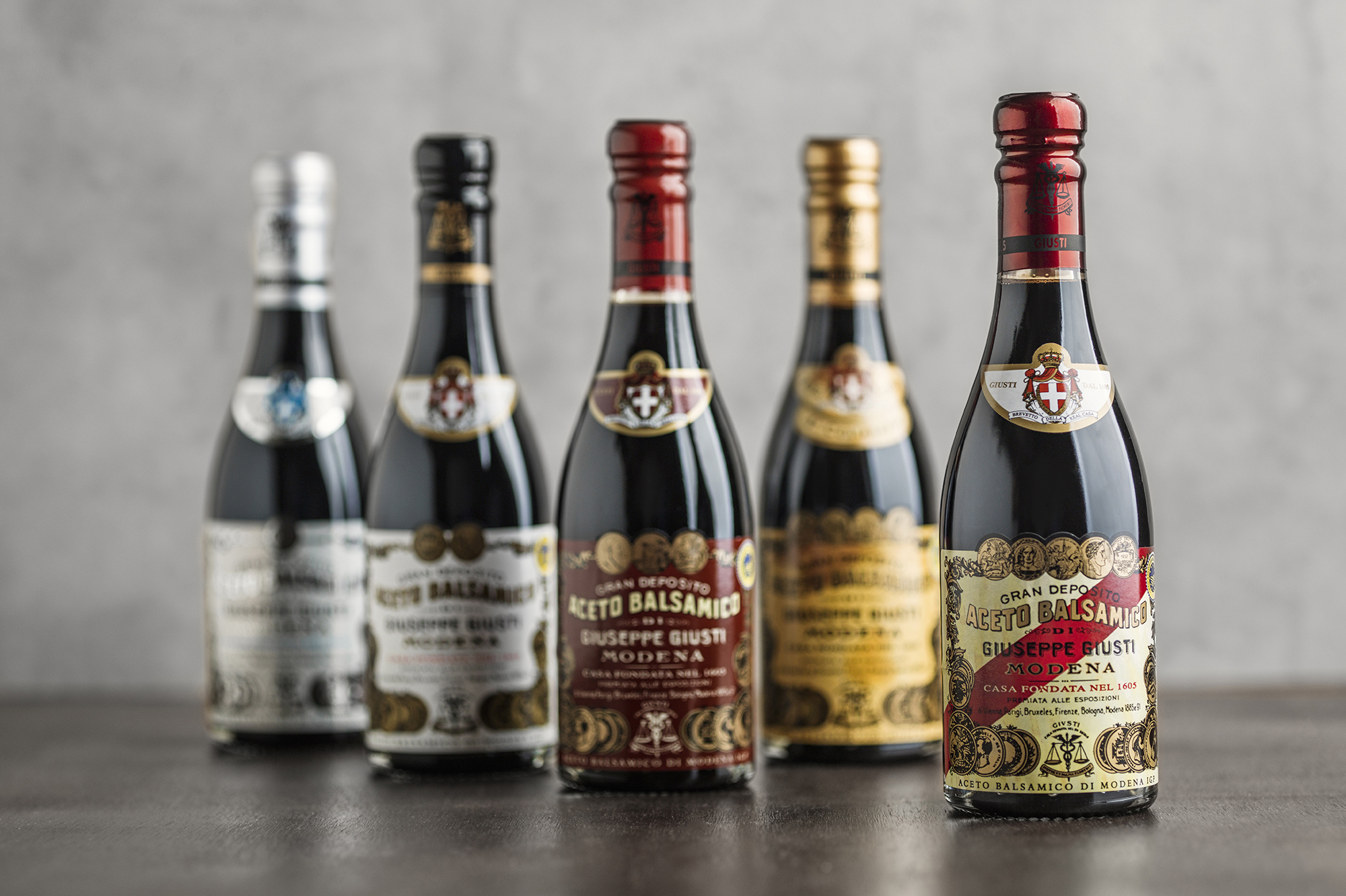
1930. The market grows and Giusti starts to bottle his balsamic vinegars in the only bottles locally available, the ones for the wine “Lambrusco”.
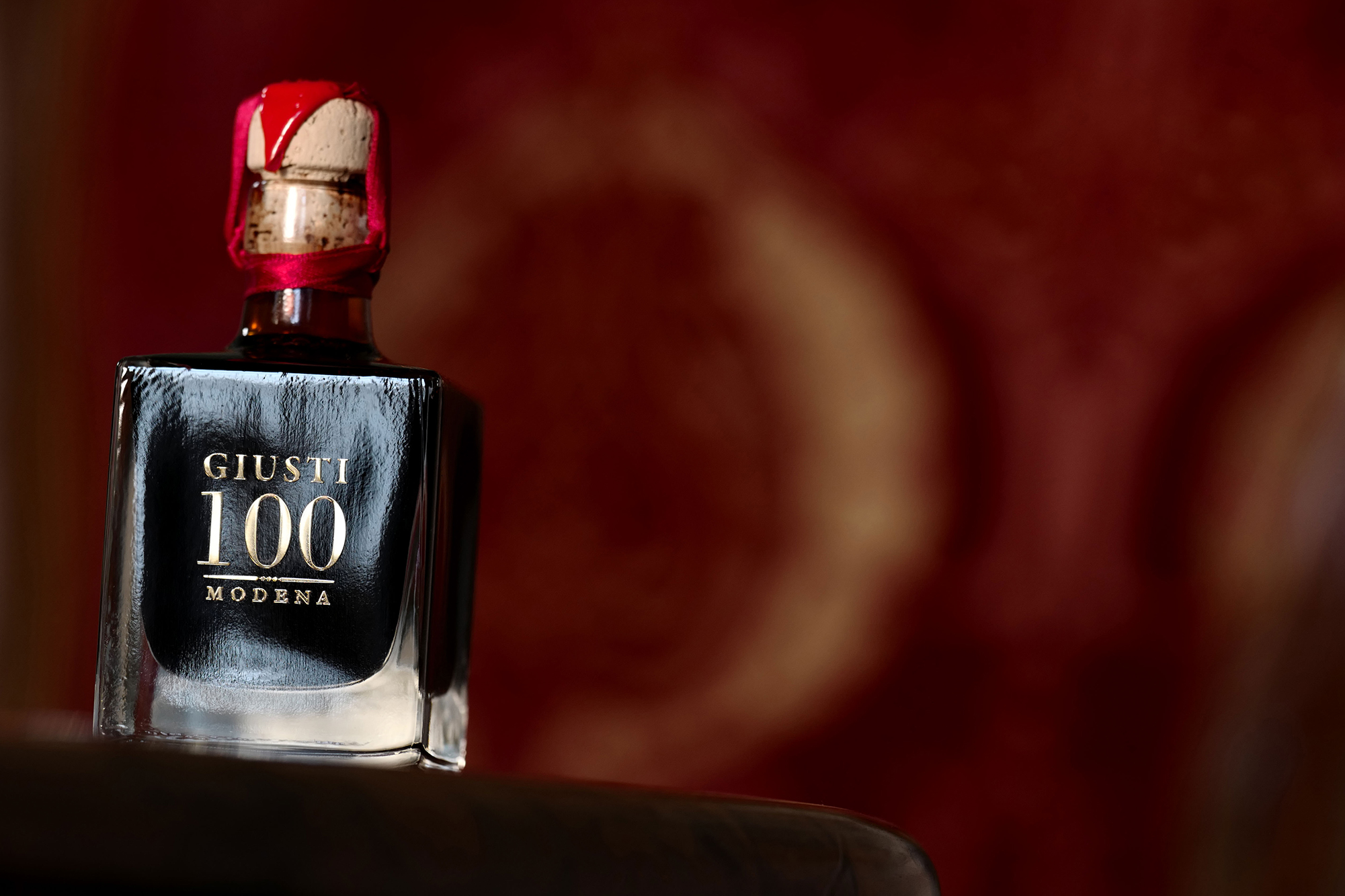
1950. The finest and oldest balsamic vinegars are bottled in smaller glasses, anticipating the Traditional Balsamic Vinegar of Modena DOP.

1990. Giusti moves from the attics of the Delicatessen in the center of Modena into a farmhouse located in the Modena countryside, opening its doors to food lovers from all over the world.
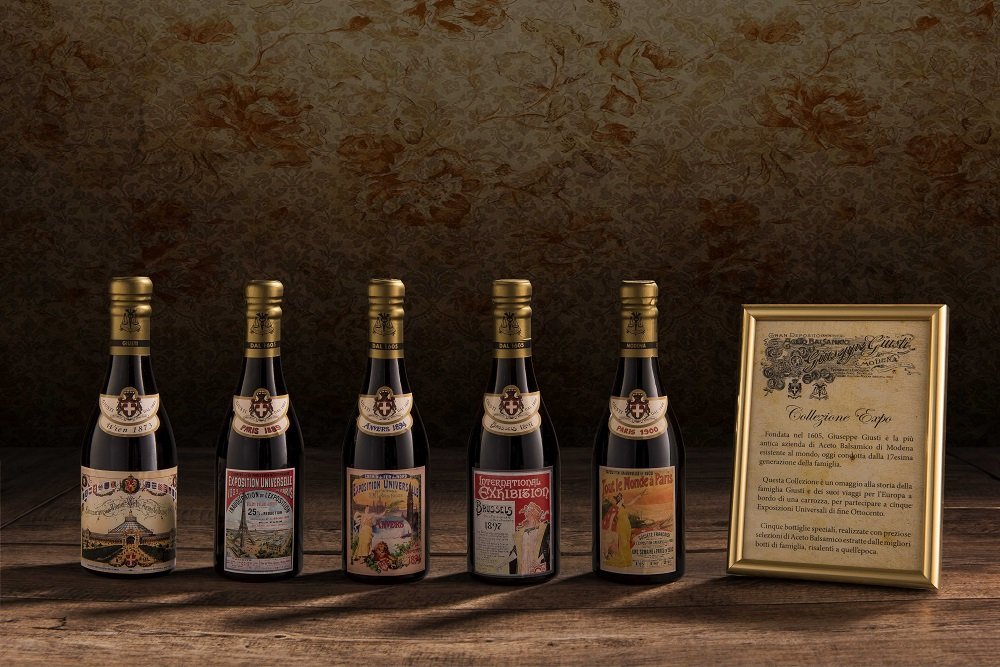
2015. Celebrating Expo Milan 2015, Giusti founds together with the Ferrari Museums the tour “Discover Ferrari & Pavarotti Land”, a program to visit the best local food excellences.
The Family

The Giusti family has directly guided the company since 1605, with passion and a long term strategy, arriving today at the 17th generation. Claudio and Francesca, together with Luciano, continue the project started by their ancestors, uniting a respect for tradition with a flexible, modern and sustainable company management, centered on well being and valorization of the people, the territory and the community with which it engages.
The Knowledge
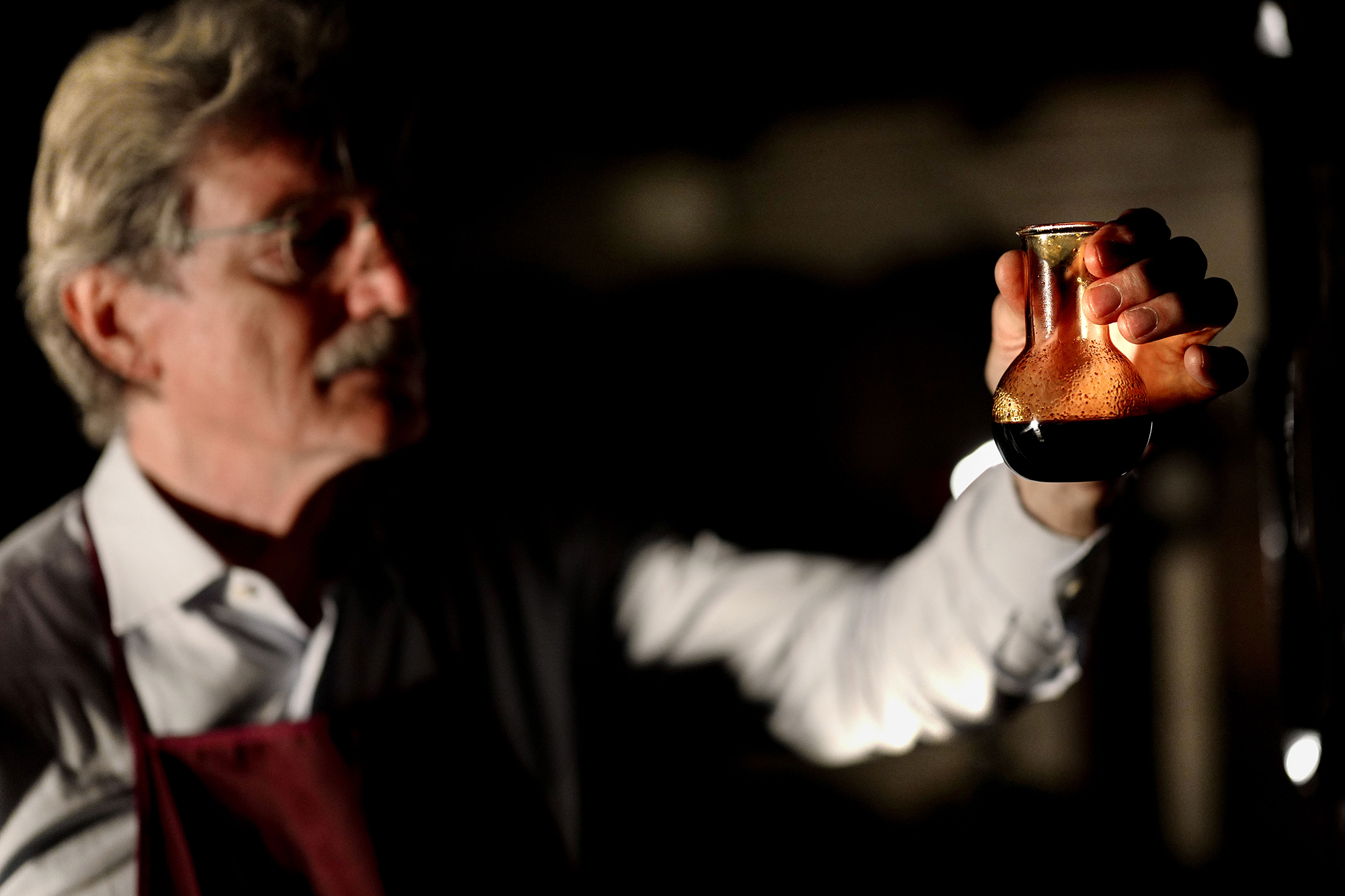
Obtaining a great balsamic vinegar depends on the competence, experience and taste of its maker. Not only a careful selection of the grapes, but also the cooking system and above all the great complexity of the ageing process, with casks of various woods and sizes. These are the factors that the “maestro acetiere” needs to manage to obtain a great result. Not to forget time, an important element for course of the natural processes; traditionally, a generation prepares the balsamic vinegar for the next generation.
The Casks

Ageing in casks is definitely the most crucial part of the creation of balsamic vinegar. The older the cask, the better the balsamic vinegar will be, as casks release an increasing intensity of wood essences and complexity of aromas from the vinegars left to age throughout the years. That’s why the heart of our production is an “acetaia” of 600 casks dating back to 18th and 19th centuries, from where the most pure extractions, responsible for the unmistakable aroma of all Giusti Balsamic Vinegars, are collected.
The Awards
![]()
Giuseppe Giusti balsamic vinegars have collected many recognitions since the company’s foundation through to today. The most meaningful awards were obtained during the Belle-Epoque, when the Giusti family presented their balsamic vinegars at the national and international food fairs. The 14 Gold Medals that characterize the famous Giusti label, designed in the early 1900s, date back to this era. In addition to these medals, there is also the Royal Seal of Approval, granted from the King of Italy in 1929.
The Museum

The Giusti family, through the centuries, has collected a great patrimony of objects and documents regarding the world of Balsamic Vinegar. From ancient ceramic vases used to store the balsamic vinegars, ancient tools, to the first bottles and advertising material of early 1900’s. To all these a Museum is dedicated, which traces and tells the centuries old history of this wonderful elixir and of its meaning to our family.
La Cuisine

Balsamic vinegar has always been an undisputed protagonist of Modena and the surrounding Emilia cuisine, considered a companion to the local principal products and dishes. Its versatility and uniqueness has also assured itself a place in the kitchens of the most innovative national and international chefs, playing a supporting role in all kinds of dishes: from shellfish and steak tartare, to oysters and foie gras. Recently it has also been rediscovered in patisserie, where along side traditional associations, such as vanilla ice cream, many new and creative applications are continuously proposed.
Local Corporate Responsability
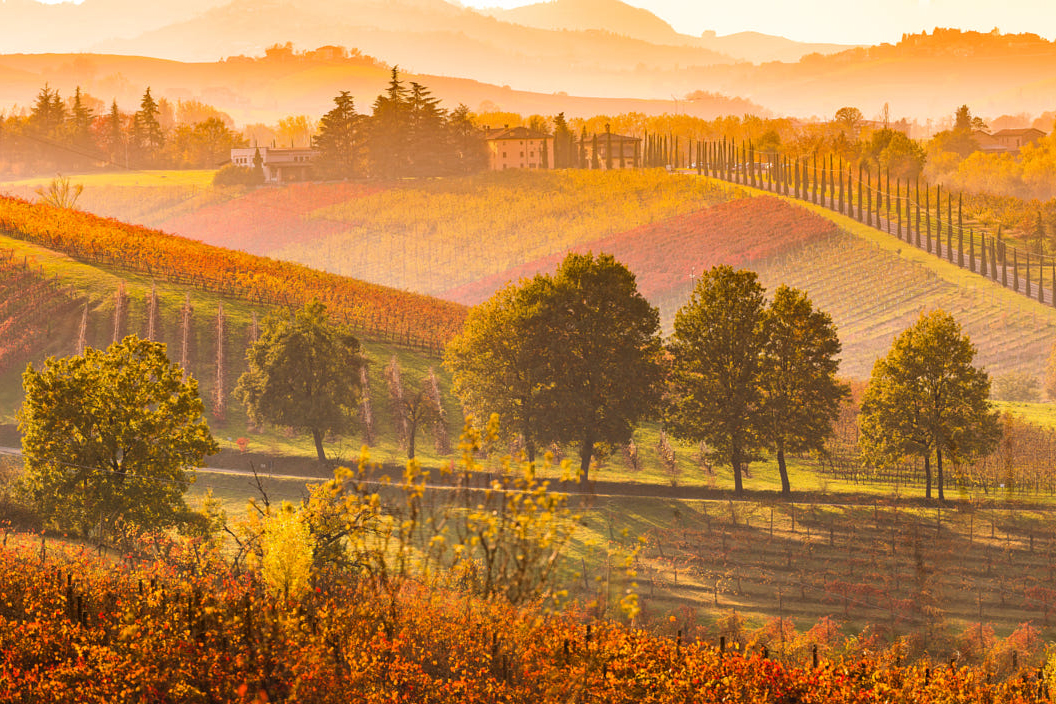
The Giusti company has become a place of meetings and contamination, where the magic of the balsamic and its barrels becomes cue to welcome other arts: music, theatre, cultural and of course gastronomical events. The Giusti family has also conceived, wanted and developed a project dedicated to the primary schools of Modena, where through play and games the children learn the secret of the production of balsamic vinegar, contributing like that to give a long-lasting life to this tradition.
“In Modena, in the attics of the antique buildings, a vinegar, or rather a rich syrup, is produced over a lifetime of cherishing and maturing in century old barrels [...]” Vincenzo Buonassisi
Giusti Day - 16|05

On 16|05, all over the world, we will celebrate the first Giusti Day in more than 80 restaurants in 21 countries in the world.

It was 1605 when the name of Francesco Maria Giusti was written on the first census of a Merchand Guild in Modena, from the new Duke Cesare D’Este.
This is the first witness of the activity of the Giusti family, the oldest producer of Balsamic Vinegar of Modena.
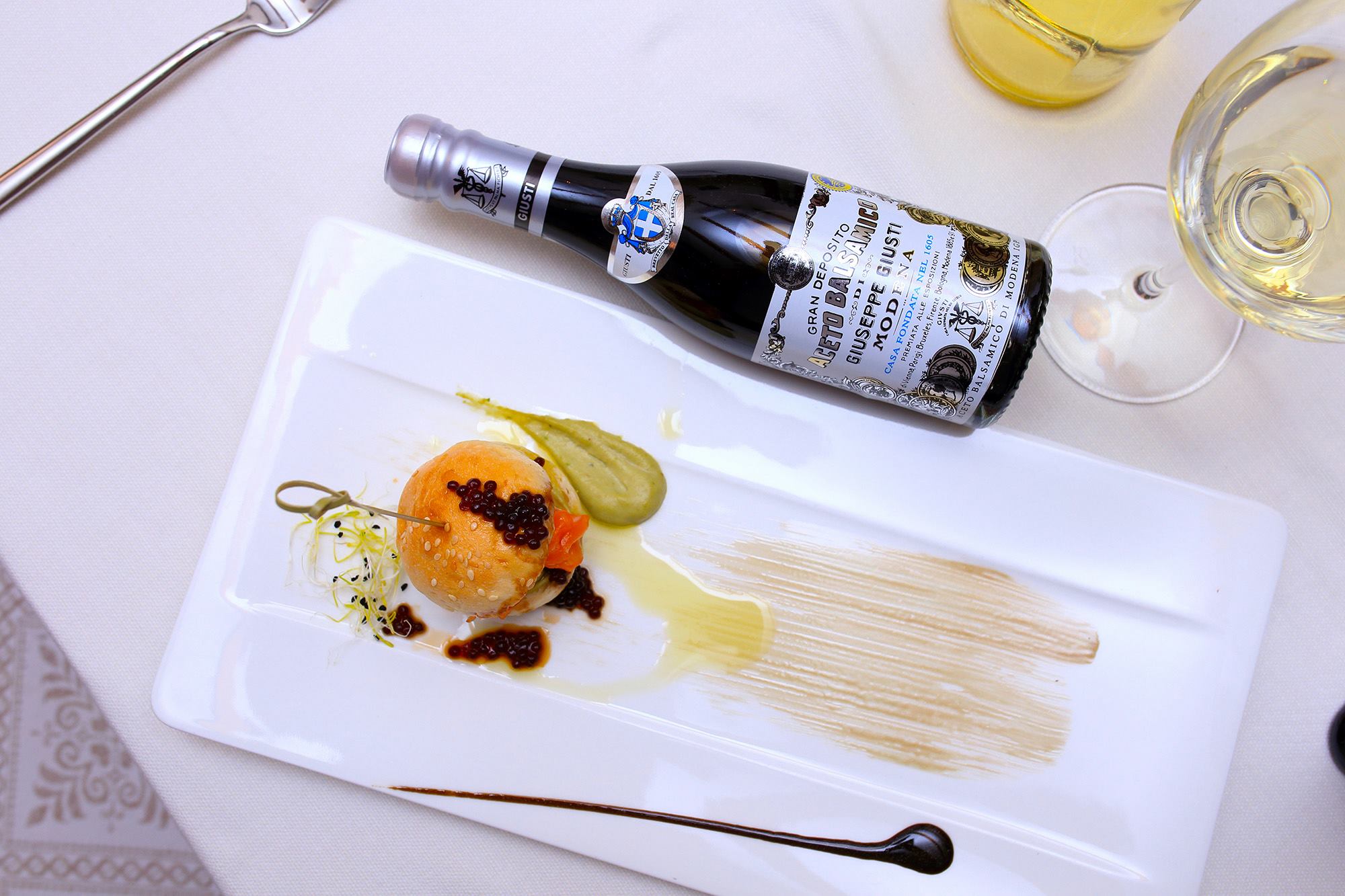
From all over the world, the participating restaurants have created dishes, drinks and different menus using our Balsamic Vinegars, proving the great versatility of this product as symbol and undisputed ambassador of the Made in Italy that makes our country unique in the world.
The History of a Barrel
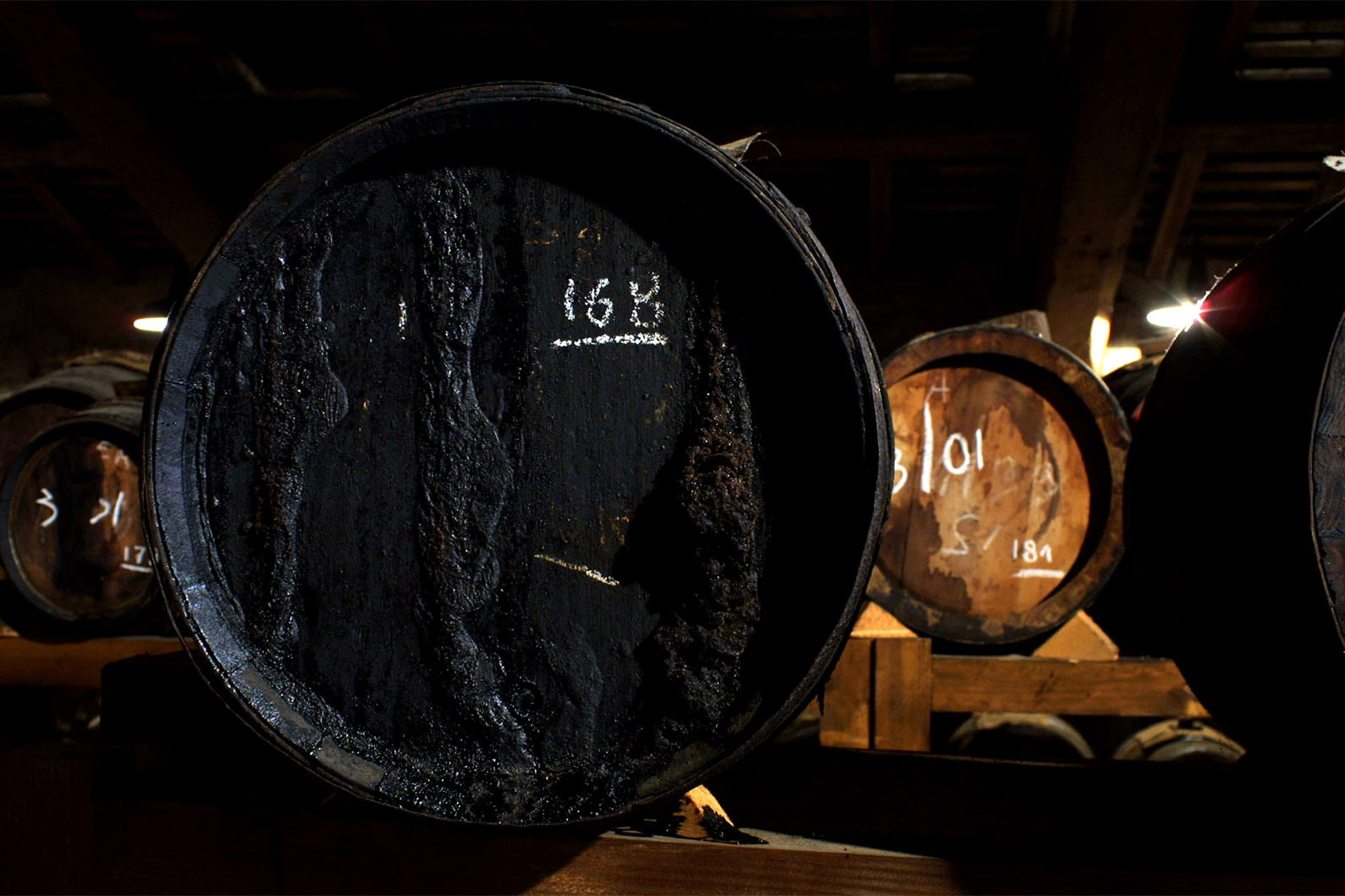
The history of a barrel home / highlight / the history of a barrel Throughout the successive centuries, generations of vinegar producers have cared for the barrels: scrupulously inspecting them, maintaining them, preserving the purity of the woods. During the many years in which Balsamic Vinegar ages in barrels, the typical flavors and aromas are released and the magic of balsamic is born. Then there is the aging process,during which the characteristics of the product earn the optimum refinement.
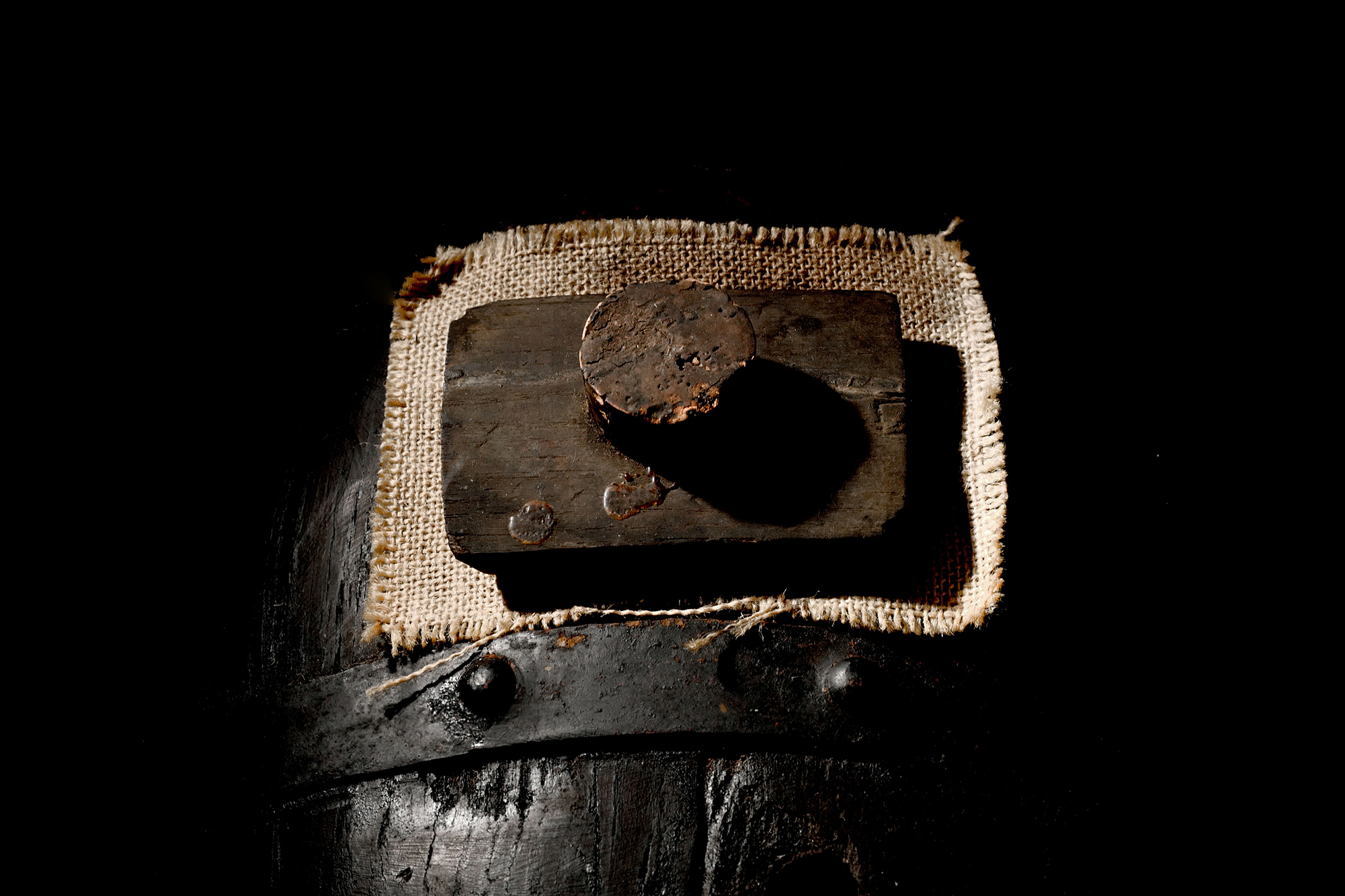
The three phases occur in a series of barrels of different type of woods, and of decreasing and variable volumes. Each wood bestows a particular characteristic to the vinegar. Chestnut, rich in tannins, is a wood of great elasticity, ideal for the creation of barrels. Over the years this wood becomes increasingly dark, thus contributing to the typical strong brown color of Balsamic Vinegar. The Mulberry is a particularly porous wood. In the past it was often used in the country to breed silkworms. Today it is highly regarded for the production of balsamic vinegar because it promotes rapid evaporation, thus increasing the concentration of the liquid. Clear in color, almost yellow, freshly prepared, with the passing of time, the wood acquires a typical dark reddish color.
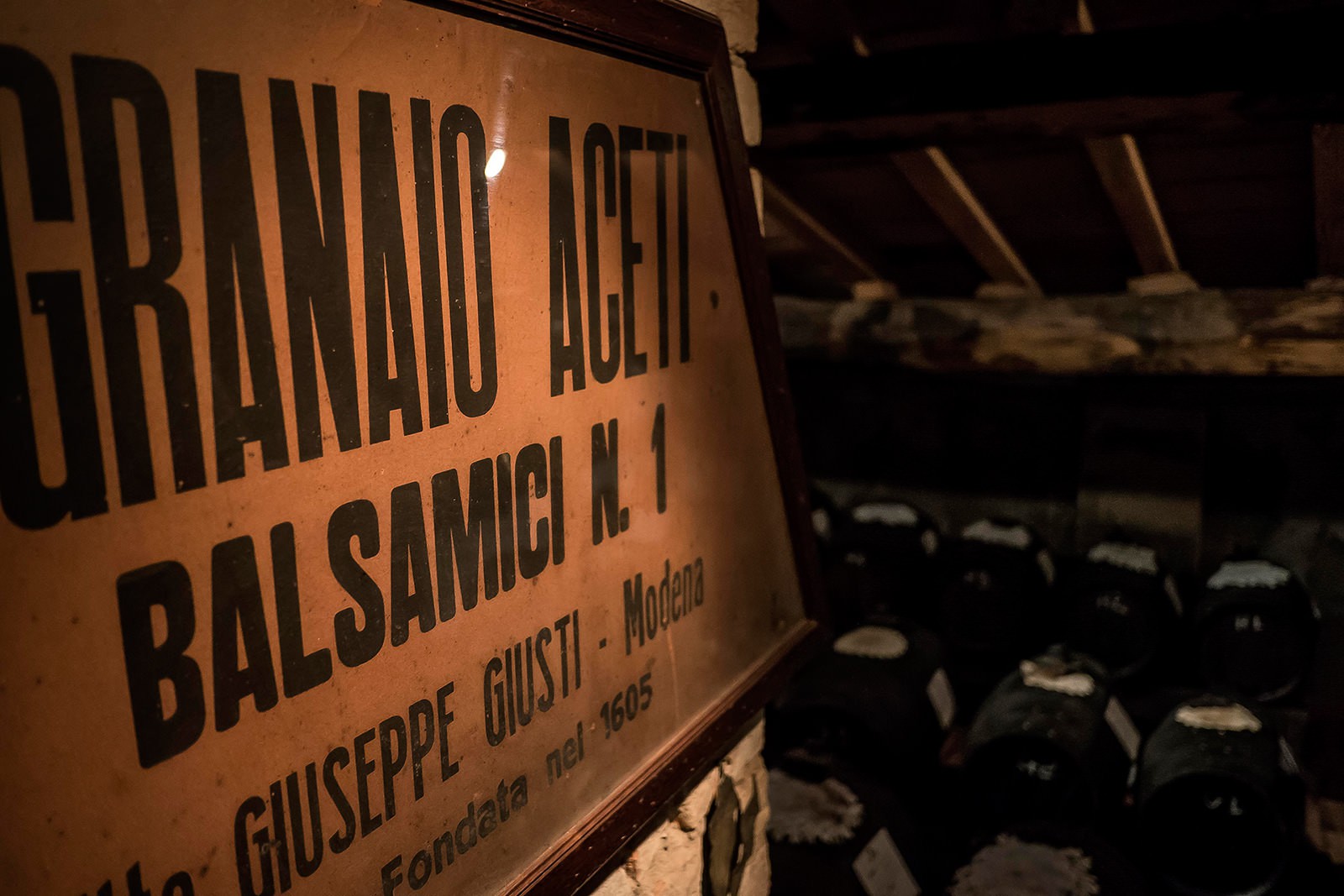
Juniper is a resinous and durable substance; a precious wood due to its ability to transfer aromas and essences of great power. The barrels made from this wood are increasingly hard to find and represent objects particularly valuable for a Balsamic Vinegar barrel collection. Cherry, of superb quality in the area of Modena, is widely used and is of a pinkish color. Extremely refined, with an aftertaste reminiscent of fruit, especially cherry, is able to emphasize the more sweet aromas of balsamic vinegar. Oak is perhaps the most commonly used wood for the production of barrels. Oak Is considered particularly valuable in the accommodation of the already mature vinegar, releasing to the liquid an improved roundness and a typical vanilla scent.
The Label, a Piece of Art
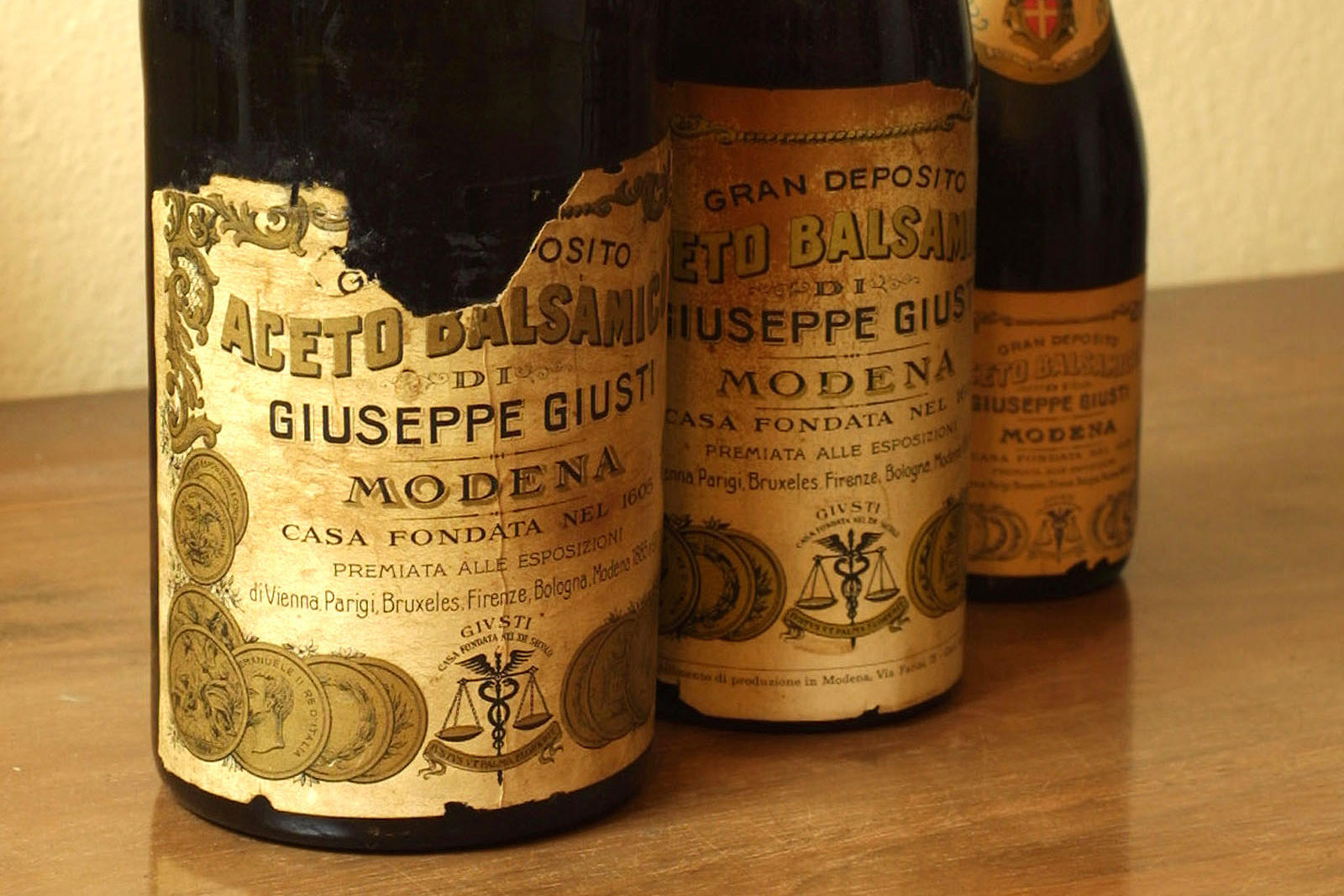
The Giusti bottle is not the sole precious heritage of the Giusti family. A museum is located at the heart of Giusti. A home for the culture of the Giusti brand. And this is the objective of the Giusti family, that in this space the antique artifacts, such as barrels, tools for production and various memorabilia, is exhibited. All in the custody of the Giusti family, including a 20 kilogram lithographic stone which was used to print the original logo.

The collection includes some documents of great historical value and a reproduction of an antique document that attests the presence of an ancestor Francesco Giusti among the LardaruolietSalciciari traders of the renaissance Modena. The original diplomas and gold medals that have been awarded to Giusti through the four centuries of commercial activity are on display. At the heart of the museum stands the barrel that Giuseppe Giusti transported from Modena to the Exposition Universelle in Paris in the late 1800’s , an event in which the Eiffel tower was inaugurated.
Mastery in Balsamic Vinegar production

The collection of barrels is organized, by tradition, in series of 5 or 7 barrels in decreasing volumes and dimensions, of various precious wood types in which the balsamic vinegar rests, absorbing along its travels the aromas and flavors these woods provide.
Each wood observes a precious and particular responsibility: the chestnut, rich in tannins, lends to the classic brown color, the cherry sweetens the flavor, the mulberry promotes oxygenation, the juniper offers the resinous essence and the oak donates the typical vanilla perfume.
Each year, according to the method of“decanting and refilling,”a remedy to the natural reduction due to evaporation is proposed, decantering the liquid from the smallest barrel in the series with vinegar from the proceeding barrel and so on, until the largest barrel which is itself refilled with cooked must.
A never-ending journey.
A continuous repetition of antique gestures, year after year.
A ritual that gives life, through the centuries, to an increasingly extraordinary Balsamic Vinegar.
Ferrari Pavarotti Land

A programme of discovery of the thousand delights of Modena and the surrounding area. With our comfortable shuttle buses or using your own transport. Discover is a tour designed to introduce visitors to a broad range of the Modena area’s facilities, businesses and monuments of excellence. These include Ferrari and its museums, the Pavarotti House and Museum, traditional gourmet balsamic vinegar, parmesan cheese, Lambrusco wine and cured meats producers and their museums, as well as the delights of the city of Modena itself and the towns of Maranello, Sassuolo and Nonantola.
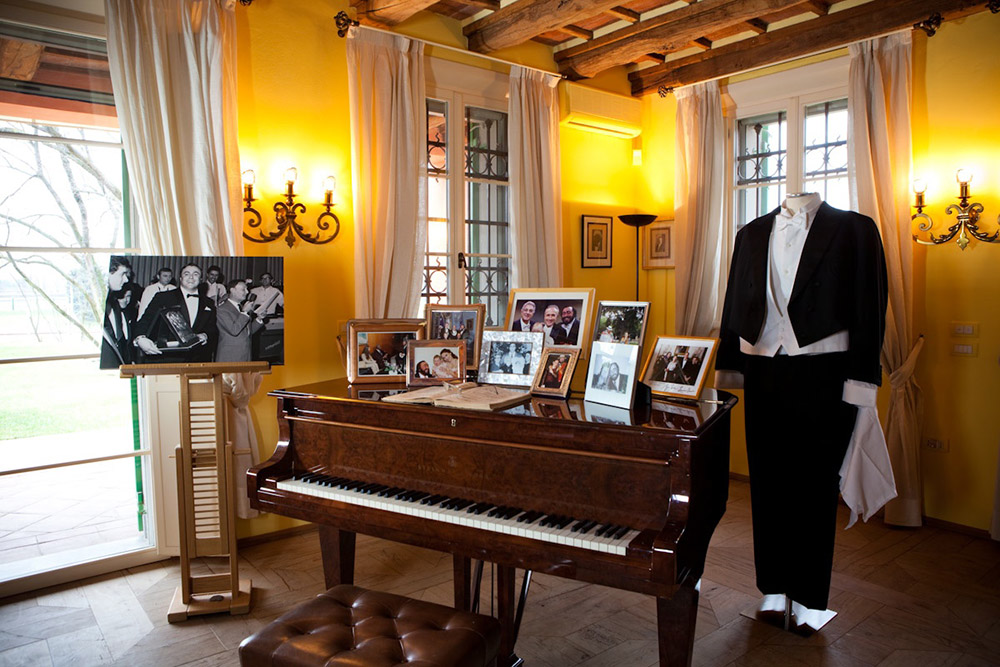
Products Gran Deposito Aceto Balsamico Giuseppe Giusti
Gran Deposito Aceto Balsamico Giuseppe Giusti
Modena since 1605 - The Oldest Vinegar Company in The World

"The perfection of the Balsamic Vinegars of Modena depends solely by three conditions: choice of the grapes, quality of the recipients and Time." G. Giusti

History - Key Milestones

1605. Giuseppe and Francesco Maria Giusti are registered in the first list of commercial activities, created by Cesare d-Este, the newly crowned Duke of Modena.

1700. The Giusti production grows through the acquisition of new casks and the purchase of others already producing balsamic vinegar from families of Modena.

1861. Giuseppe Giusti brings the A3 barrel to the Italian National Fair in Florence, authorized by the Italian Royal family, and is awarded a gold medal for his “90 years old balsamic vinegar”.

1863. During a Fair in Modena, Giuseppe Giusti presents the first document of his “golden rules” for the “perfect balsamic vinegar”.

1880. The first “Commercial Samples” of Giusti Balsamic Vinegar are sent by post, anticipatig its future diffusion throughout Italy and Europe.

1889 - 1900. Giusti participates at International Fairs, from Paris to Antwerp, accumulating awards and medals for the outstanding quality of its balsamic vinegars.

1900. The boutique, opened in the early 1600’s, becomes the “Premiata Salumeria Gisuti”, remaining throughout the centuries a point of reference for food lovers and local gourmet excellences.

1929. Giusti becomes the official supplier of the King of Italy, the Savoia family, who grants the right to add the Royal Seal of Approval to Giusti products.

1930. The market grows and Giusti starts to bottle his balsamic vinegars in the only bottles locally available, the ones for the wine “Lambrusco”.

1950. The finest and oldest balsamic vinegars are bottled in smaller glasses, anticipating the Traditional Balsamic Vinegar of Modena DOP.

1990. Giusti moves from the attics of the Delicatessen in the center of Modena into a farmhouse located in the Modena countryside, opening its doors to food lovers from all over the world.

2015. Celebrating Expo Milan 2015, Giusti founds together with the Ferrari Museums the tour “Discover Ferrari & Pavarotti Land”, a program to visit the best local food excellences.
The Family

The Giusti family has directly guided the company since 1605, with passion and a long term strategy, arriving today at the 17th generation. Claudio and Francesca, together with Luciano, continue the project started by their ancestors, uniting a respect for tradition with a flexible, modern and sustainable company management, centered on well being and valorization of the people, the territory and the community with which it engages.
The Knowledge

Obtaining a great balsamic vinegar depends on the competence, experience and taste of its maker. Not only a careful selection of the grapes, but also the cooking system and above all the great complexity of the ageing process, with casks of various woods and sizes. These are the factors that the “maestro acetiere” needs to manage to obtain a great result. Not to forget time, an important element for course of the natural processes; traditionally, a generation prepares the balsamic vinegar for the next generation.
The Casks

Ageing in casks is definitely the most crucial part of the creation of balsamic vinegar. The older the cask, the better the balsamic vinegar will be, as casks release an increasing intensity of wood essences and complexity of aromas from the vinegars left to age throughout the years. That’s why the heart of our production is an “acetaia” of 600 casks dating back to 18th and 19th centuries, from where the most pure extractions, responsible for the unmistakable aroma of all Giusti Balsamic Vinegars, are collected.
The Awards
![]()
Giuseppe Giusti balsamic vinegars have collected many recognitions since the company’s foundation through to today. The most meaningful awards were obtained during the Belle-Epoque, when the Giusti family presented their balsamic vinegars at the national and international food fairs. The 14 Gold Medals that characterize the famous Giusti label, designed in the early 1900s, date back to this era. In addition to these medals, there is also the Royal Seal of Approval, granted from the King of Italy in 1929.
The Museum

The Giusti family, through the centuries, has collected a great patrimony of objects and documents regarding the world of Balsamic Vinegar. From ancient ceramic vases used to store the balsamic vinegars, ancient tools, to the first bottles and advertising material of early 1900’s. To all these a Museum is dedicated, which traces and tells the centuries old history of this wonderful elixir and of its meaning to our family.
La Cuisine

Balsamic vinegar has always been an undisputed protagonist of Modena and the surrounding Emilia cuisine, considered a companion to the local principal products and dishes. Its versatility and uniqueness has also assured itself a place in the kitchens of the most innovative national and international chefs, playing a supporting role in all kinds of dishes: from shellfish and steak tartare, to oysters and foie gras. Recently it has also been rediscovered in patisserie, where along side traditional associations, such as vanilla ice cream, many new and creative applications are continuously proposed.
Local Corporate Responsability

The Giusti company has become a place of meetings and contamination, where the magic of the balsamic and its barrels becomes cue to welcome other arts: music, theatre, cultural and of course gastronomical events. The Giusti family has also conceived, wanted and developed a project dedicated to the primary schools of Modena, where through play and games the children learn the secret of the production of balsamic vinegar, contributing like that to give a long-lasting life to this tradition.
“In Modena, in the attics of the antique buildings, a vinegar, or rather a rich syrup, is produced over a lifetime of cherishing and maturing in century old barrels [...]” Vincenzo Buonassisi
Giusti Day - 16|05

On 16|05, all over the world, we will celebrate the first Giusti Day in more than 80 restaurants in 21 countries in the world.

It was 1605 when the name of Francesco Maria Giusti was written on the first census of a Merchand Guild in Modena, from the new Duke Cesare D’Este.
This is the first witness of the activity of the Giusti family, the oldest producer of Balsamic Vinegar of Modena.

From all over the world, the participating restaurants have created dishes, drinks and different menus using our Balsamic Vinegars, proving the great versatility of this product as symbol and undisputed ambassador of the Made in Italy that makes our country unique in the world.
The History of a Barrel

The history of a barrel home / highlight / the history of a barrel Throughout the successive centuries, generations of vinegar producers have cared for the barrels: scrupulously inspecting them, maintaining them, preserving the purity of the woods. During the many years in which Balsamic Vinegar ages in barrels, the typical flavors and aromas are released and the magic of balsamic is born. Then there is the aging process,during which the characteristics of the product earn the optimum refinement.

The three phases occur in a series of barrels of different type of woods, and of decreasing and variable volumes. Each wood bestows a particular characteristic to the vinegar. Chestnut, rich in tannins, is a wood of great elasticity, ideal for the creation of barrels. Over the years this wood becomes increasingly dark, thus contributing to the typical strong brown color of Balsamic Vinegar. The Mulberry is a particularly porous wood. In the past it was often used in the country to breed silkworms. Today it is highly regarded for the production of balsamic vinegar because it promotes rapid evaporation, thus increasing the concentration of the liquid. Clear in color, almost yellow, freshly prepared, with the passing of time, the wood acquires a typical dark reddish color.

Juniper is a resinous and durable substance; a precious wood due to its ability to transfer aromas and essences of great power. The barrels made from this wood are increasingly hard to find and represent objects particularly valuable for a Balsamic Vinegar barrel collection. Cherry, of superb quality in the area of Modena, is widely used and is of a pinkish color. Extremely refined, with an aftertaste reminiscent of fruit, especially cherry, is able to emphasize the more sweet aromas of balsamic vinegar. Oak is perhaps the most commonly used wood for the production of barrels. Oak Is considered particularly valuable in the accommodation of the already mature vinegar, releasing to the liquid an improved roundness and a typical vanilla scent.
The Label, a Piece of Art

The Giusti bottle is not the sole precious heritage of the Giusti family. A museum is located at the heart of Giusti. A home for the culture of the Giusti brand. And this is the objective of the Giusti family, that in this space the antique artifacts, such as barrels, tools for production and various memorabilia, is exhibited. All in the custody of the Giusti family, including a 20 kilogram lithographic stone which was used to print the original logo.

The collection includes some documents of great historical value and a reproduction of an antique document that attests the presence of an ancestor Francesco Giusti among the LardaruolietSalciciari traders of the renaissance Modena. The original diplomas and gold medals that have been awarded to Giusti through the four centuries of commercial activity are on display. At the heart of the museum stands the barrel that Giuseppe Giusti transported from Modena to the Exposition Universelle in Paris in the late 1800’s , an event in which the Eiffel tower was inaugurated.
Mastery in Balsamic Vinegar production

The collection of barrels is organized, by tradition, in series of 5 or 7 barrels in decreasing volumes and dimensions, of various precious wood types in which the balsamic vinegar rests, absorbing along its travels the aromas and flavors these woods provide.
Each wood observes a precious and particular responsibility: the chestnut, rich in tannins, lends to the classic brown color, the cherry sweetens the flavor, the mulberry promotes oxygenation, the juniper offers the resinous essence and the oak donates the typical vanilla perfume.
Each year, according to the method of“decanting and refilling,”a remedy to the natural reduction due to evaporation is proposed, decantering the liquid from the smallest barrel in the series with vinegar from the proceeding barrel and so on, until the largest barrel which is itself refilled with cooked must.
A never-ending journey.
A continuous repetition of antique gestures, year after year.
A ritual that gives life, through the centuries, to an increasingly extraordinary Balsamic Vinegar.
Ferrari Pavarotti Land

A programme of discovery of the thousand delights of Modena and the surrounding area. With our comfortable shuttle buses or using your own transport. Discover is a tour designed to introduce visitors to a broad range of the Modena area’s facilities, businesses and monuments of excellence. These include Ferrari and its museums, the Pavarotti House and Museum, traditional gourmet balsamic vinegar, parmesan cheese, Lambrusco wine and cured meats producers and their museums, as well as the delights of the city of Modena itself and the towns of Maranello, Sassuolo and Nonantola.

Products Gran Deposito Aceto Balsamico Giuseppe Giusti
-
Acetaia Giuseppe Giusti - Modena 1605 - 1 Silver Medal - Balsamic Vinegar of...
Characterized by a rich perfume and an agreeable and rounded balsamic acidity, the “Medaglia d’Argento” is an aromatic balsamic vinegar, enhancing the flavors of any dish with its intensity. In cuisine it can be used fresh or can be heated in cooking preparations.
12,50 € -
Acetaia Giuseppe Giusti - Modena 1605 - 2 Gold Medals - The Classic -...
A classic for the Giusti family, “Il Classico” is a greatly versatile balsamic, used fresh or heated. Of a good density and optimal balance between the sweet and sour, it is characterized by overtones of mature fruits, licorice and black pepper.
17,50 € -
Acetaia Giuseppe Giusti - Modena 1605 - 3 Gold Medals - Riccardo Giusti -...
Dedicated to the ancestor who created the recipe at the beginning of the 20th century, this balsamic is born from sweet, sundried grapes. Aromas and flavors of plum jam and red fruits intertwine with hints of honey and vanilla in a considerable dense and sweet balsamic, perfect as a fresh dressing for various savory or sweet dishes.
22,90 € -
Acetaia Giuseppe Giusti - Modena 1605 - 4 Gold Medals - Quarto Centenario -...
Born for the celebration of the 400 years of the Giusti family production, the “Quarto Centenario” is a balsamic of extreme fullness, deeply aromatic, with scents of ripe fruits, accompanied by notes of tobacco, roasted coffee and hints of wood, thanks to its long ageing.
34,90 € -
Acetaia Giuseppe Giusti - Modena 1605 - 5 Gold Medals - Banda Rossa -...
The ultimate pride and expression of the art of Giusti vinegars, the “Banda Rossa” was the personal gift from Uncle Giuseppe to family members. Of great body and concentration, it is distinguished by its extraordinary complexity and rich bouquet of aromas. Notes of plum, black cherries and sweet spices, infused with the fragrances of ancient woods in...
57,50 € -
Acetaia Giuseppe Giusti - Modena 1605 - The Traditional - Affined - Balsamic...
The “Tradizionale” is the maximum expression of balsamic vinegars, from the lofts of the houses of Modena. Obtained from the single ingredient of cooked grape must, it is slowly aged according to the ancient system of “Decanters and Refills,” in antique series of barrels of various woods.
90,00 € -
Acetaia Giuseppe Giusti - Modena 1605 - The Traditional - Extraold - Balsamic...
The “Tradizionale” is the maximum expression of balsamic vinegars, from the lofts of the houses of Modena. Obtained from the single ingredient of cooked grape must, it is slowly aged according to the ancient system of “Decanters and Refills,” in antique series of barrels of various woods.
120,00 € -
Acetaia Giuseppe Giusti - Modena 1605 - Giusti Riserva - 50 Years - Exclusive...
The “Riserve” are the most exclusive of the Giusti collection and is produced each year in extremely limited quantities, extracted from some precious series of barrels in production since 1700. One of these barrels, coded as A3, was brought by Giusti to the National Fair of Florence in 1861, where a “vinegar of 90 years” was awarded a gold medal,...
350,00 € -
Acetaia Giuseppe Giusti - Modena 1605 - Giusti Riserva - 100 Years -...
The “Riserve” are the most exclusive of the Giusti collection and is produced each year in extremely limited quantities, extracted from some precious series of barrels in production since 1700. One of these barrels, coded as A3, was brought by Giusti to the National Fair of Florence in 1861, where a “vinegar of 90 years” was awarded a gold medal,...
589,00 € -
Acetaia Giuseppe Giusti - Modena 1605 - The Scrigno - Wooden Gift Collections...
Born from a request by Maestro Luciano Pavarotti in 2006 for a single object, to be proposed at a charity auction supported by his Foundation. The Giusti family created the “Scrigno”, a precious wooden box containing the entire historical collection in the classic “Champagnotta” format, alongside five premium balsamic vinegars aged in single barrels of...
245,00 € -
Acetaia Giuseppe Giusti - Modena 1605 - 5 Champagnottine - Wooden Gift...
Born from a request by Maestro Luciano Pavarotti in 2006 for a single object, to be proposed at a charity auction supported by his Foundation. The Giusti family created the “Scrigno”, a precious wooden box containing the entire historical collection in the classic “Champagnotta” format, alongside five premium balsamic vinegars aged in single barrels of...
120,00 € -
Acetaia Giuseppe Giusti - Modena 1605 - 5 Champagnotte - Wooden Gift...
Born from a request by Maestro Luciano Pavarotti in 2006 for a single object, to be proposed at a charity auction supported by his Foundation. The Giusti family created the “Scrigno”, a precious wooden box containing the entire historical collection in the classic “Champagnotta” format, alongside five premium balsamic vinegars aged in single barrels of...
180,00 € -
Acetaia Giuseppe Giusti - Modena 1605 - Duetto Rustico - Wooden Gift...
A wooden box which encases two classic vinegars from the Acetaia Giusti: the “Two Gold Medals”, a fragrant balsamic with a great aromatic intensity, and “Three Gold Medals”, characterized by a high density and sweetness.
46,90 € -
Acetaia Giuseppe Giusti - Modena 1605 - Organic - Balsamic Vinegar of Modena...
The Giusti organic balsamic vinegar is made with organic grape must and organic wine vinegar, from thoughtful and sustainable farming. The result is a fragrant and spicy balsamic, characterized by a strong balsamic acidity, balanced by the sweetness of the must. Ideal added to a mixed leaf salad, and vegetable entrées. It can also be added to meats,...
13,00 € -
Acetaia Giuseppe Giusti - Modena 1605 - White Condiment - Balsamic Vinegar of...
The White Giusti condiment is born from a soft pressing of Trebbiano grapes, from which a particularly sweet juice is obtained. This is then combined with high quality white vinegars and aged in french oak and ash wooden barrels. This process keeps all the fruity and floral aromas of the grapes, creating a very pleasant condiment, thanks to the contrast...
13,00 € -
Acetaia Giuseppe Giusti - Modena 1605 - Black Pearls of Balsamic Vinegar of...
Through the spherification process in sodium alginate, a technique used in molecular gastronomy, the Giusti Balsamic Vinegar of Modena 1 Medal for the black pearls, and the Giusti White Condiment for the white pearls, are entrapped in spheres the dimensions of caviar, giving a completely new consistency and adaptability to particularly creative applications.
12,00 € -
Acetaia Giuseppe Giusti - Modena 1605 - White Sicilian Salt with Balsamic...
The Giusti Balsamic Vinegar of Modena 2 Gold Medals is united with White Sicilian Salt, through a fusion of the salt and the addition of the balsamic vinegar. During the cooling process, the two products are crystalized together forming a piece that, subsequently crushed, gives rise to balsamic vinegar salt crystals.
6,00 €Sold Out - Not Available -
Acetaia Giuseppe Giusti - Modena 1605 - Chocolates with Balsamic Vinegar of...
Italy has a great chocolate tradition, especially strong in the region of Piemonte, whose pastry chefs create unique products appreciated all around the world. The combination of balsamic vinegar with chocolate is unusual, yet it is pleasantly surprising how these two elements coexist.
17,50 € -
Acetaia Giuseppe Giusti - Modena 1605 - Panettone with Balsamic Vinegar of...
Giusti together with Antica Pasticceria Muzzi, historical italian bakery, designed a unique “panettone”, combining the best of the Milanese traditions with those of Modena. The sweet and sour of the balsamic vinegar is a perfect complement to the fragrant softness of the panettone.
24,00 €



